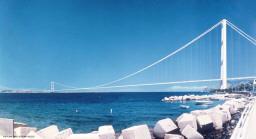Work on building the world's longest suspension bridge across the Messina Straits will start next year, the CEO of the contracting company said Friday.
''We've cleared up all the problems due to the long postponement and the building sites should open at the beginning of 2010,'' said Societa' Stretto di Messina chief Pietro Ciucci.
''As soon as we got the green light from the transport ministry we made major steps forward to speed up the process,'' he said.
The bridge was originally greenlighted by Italian Premier Silvio Berlusconi eight years ago but shelved by an intervening centre-left government.
Berlusconi's centre-right administration recently revived it.
The premier recently reaffirmed the bridge's importance for Italy.
''We consider the Messina Bridge a priority because it will give Sicilians 100% status as Italian citizens,'' the premier said.
He stressed the money would be found for the 6.5-billion-euro project despite the hundreds of millions of euros that are needed for reconstruction after the April 6 Abruzzo earthquake.
The Messina Bridge has been hailed by Berlusconi's government as a huge job-creation scheme that would give Italy's image a major boost while bringing Sicily closer to the mainland in both physical, social and psychological terms.
The project was originally presented by Berlusconi's 2001-2006 government, after it had been a key campaign promise in the 2001 general election, but was shelved during the two-year centre-left government headed by Romano Prodi.
According to Prodi's transport minister, Alessandro Bianchi, the multi-billion-euro project, was ''the most useless and damaging project in Italy in the last 100 years''.
However, during his successful election campaign last year, Berlusconi renewed his pledge to build the bridge as part of a 17.8-billion-euro public works package aimed at creating 140,000 jobs and kickstarting the ailing economy.
The project has been opposed by environmentalists and dogged by concerns over its safety and fears of potential Mafia involvement.
When and if completed, the bridge would replace ferry services between Sicily and the mainland.
The 3,690-metre-long bridge has been designed to handle 4,500 cars an hour and 200 trains a day.
Work on the 6.5-billion-euro structure was originally scheduled to start in late 2006 and end in 2012.
Current estimates are for getting construction started in mid-2010 and completing the bridge in 2016.












